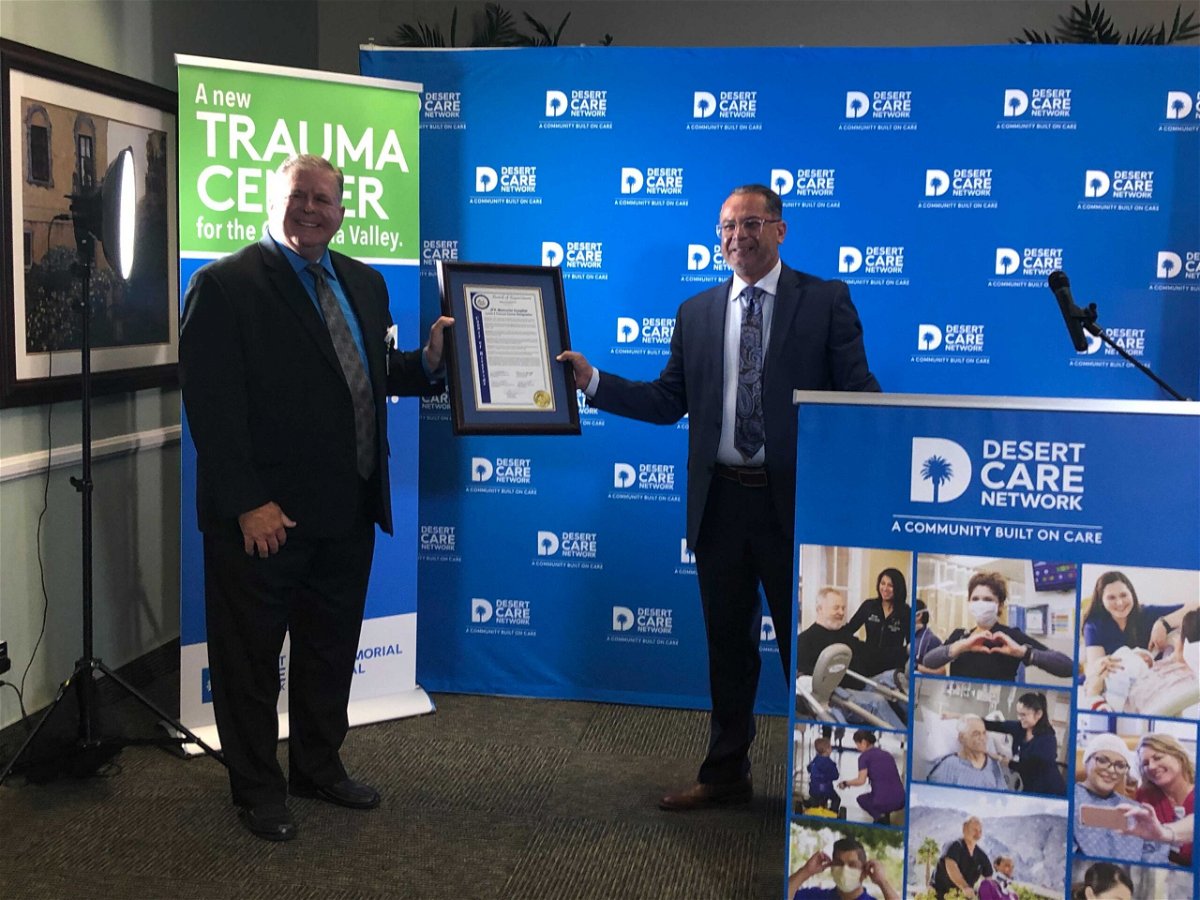JFK Memorial Hospital now serving Eastern Coachella Valley as a Level 4 Trauma Center
JFK Memorial Hospital in Indio is now designated as a Level 4 Trauma Center.
Officials celebrated Thursday morning at the hospital.
"As the first Level 4 Trauma Center in Riverside County and the first trauma center in the Eastern Coachella Valley, JFK Memorial Hospital will provide 24/7 advanced trauma life support to patients in need." said Todd Burke, Media and Public Relations for Desert Care Network, in a statement to News Channel 3 ahead of the event.

"This will deliver a higher level of care for residents in Indio and the surrounding communities."
Todd Burke, Desert Care Network
President and CEO of JFK Memorial Hospital, Gary Honts, said the hospital’s new designation enables doctors to offer a wider range of medical care that includes blunt trauma, significant falls and head injuries, shots and knife wounds, burns, as well as auto and motorcycle accidents.
JFK can also handle minor pediatric trauma cases, and evaluate and transfer patients to its sister facility, Desert Regional Medical Center in Palm Springs, if a higher level of care is needed.
According to Honts, JFK has handled 45 trauma cases since started offering trauma services on September 1, 2021.
According to the American Trauma Society, "Trauma center levels across the United States are identified in two fashions – A designation process and a verification process. The different levels (ie. Level I, II, III, IV or V) refer to the kinds of resources available in a trauma center and the number of patients admitted yearly. These are categories that define national standards for trauma care in hospitals."
In Riverside County, Riverside County Ems Agency (REMSA) sets
Desert Regional Medical Center is a Level II Trauma Center. The only Level I Trauma Center in Riverside County is Riverside Community Hospital, which was designated in the summer of 2020. A list of Verified Trauma Centers is in California here.

Trauma Center Levels, as defined by American Trauma Society
Trauma categories vary from state to state. Outlined below are common criteria for Trauma Centers verified by the ACS and also designated by states and municipalities. Facilities are designated/verified as Adult and/or Pediatric Trauma Centers. It is not uncommon for facilities to have different designations for each group (ie. a Trauma Center may be a Level I Adult facility and also a Level II Pediatric Facility).
Level I
Level I Trauma Center is a comprehensive regional resource that is a tertiary care facility central to the trauma system. A Level I Trauma Center is capable of providing total care for every aspect of injury – from prevention through rehabilitation.
Elements of Level I Trauma Centers Include:
- 24-hour in-house coverage by general surgeons, and prompt availability of care in specialties such as orthopedic surgery, neurosurgery, anesthesiology, emergency medicine, radiology, internal medicine, plastic surgery, oral and maxillofacial, pediatric and critical care.
- Referral resource for communities in nearby regions.
- Provides leadership in prevention, public education to surrounding communities.
- Provides continuing education of the trauma team members.
- Incorporates a comprehensive quality assessment program.
- Operates an organized teaching and research effort to help direct new innovations in trauma care.
- Program for substance abuse screening and patient intervention.
- Meets minimum requirement for annual volume of severely injured patients.
Level II
A Level II Trauma Center is able to initiate definitive care for all injured patients.
Elements of Level II Trauma Centers Include:
- 24-hour immediate coverage by general surgeons, as well as coverage by the specialties of orthopedic surgery, neurosurgery, anesthesiology, emergency medicine, radiology and critical care.
- Tertiary care needs such as cardiac surgery, hemodialysis and microvascular surgery may be referred to a Level I Trauma Center.
- Provides trauma prevention and continuing education programs for staff.
- Incorporates a comprehensive quality assessment program.
Level III
A Level III Trauma Center has demonstrated an ability to provide prompt assessment, resuscitation, surgery, intensive care and stabilization of injured patients and emergency operations.
Elements of Level III Trauma Centers Include:
- 24-hour immediate coverage by emergency medicine physicians and the prompt availability of general surgeons and anesthesiologists.
- Incorporates a comprehensive quality assessment program.
- Has developed transfer agreements for patients requiring more comprehensive care at a Level I or Level II Trauma Center.
- Provides back-up care for rural and community hospitals.
- Offers continued education of the nursing and allied health personnel or the trauma team.
- Involved with prevention efforts and must have an active outreach program for its referring communities.
Level IV
A Level IV Trauma Center has demonstrated an ability to provide advanced trauma life support (ATLS) prior to transfer of patients to a higher level trauma center. It provides evaluation, stabilization, and diagnostic capabilities for injured patients.
Elements of Level IV Trauma Centers Include:
- Basic emergency department facilities to implement ATLS protocols and 24-hour laboratory coverage. Available trauma nurse(s) and physicians available upon patient arrival.
- May provide surgery and critical-care services if available.
- Has developed transfer agreements for patients requiring more comprehensive care at a Level I or Level II Trauma Center.
- Incorporates a comprehensive quality assessment program.
- Involved with prevention efforts and must have an active outreach program for its referring communities.
Level V
A Level V Trauma Center provides initial evaluation, stabilization and diagnostic capabilities and prepares patients for transfer to higher levels of care.
Elements of Level V Trauma Centers Include:
- Basic emergency department facilities to implement ATLS protocols.
- Available trauma nurse(s) and physicians available upon patient arrival.
- After-hours activation protocols if facility is not open 24-hours a day.
- May provide surgery and critical-care services if available.
- Has developed transfer agreements for patients requiring more comprehensive care at a Level I through III Trauma Centers.